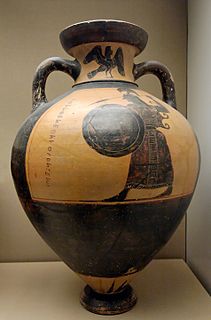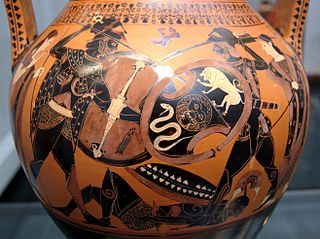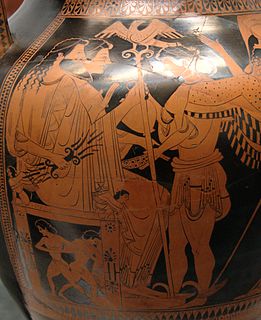
Black-figure pottery painting, also known as the black-figure style or black-figure ceramic, is one of the styles of painting on antique Greek vases. It was especially common between the 7th and 5th centuries BC, although there are specimens dating as late as the 2nd century BC. Stylistically it can be distinguished from the preceding orientalizing period and the subsequent red-figure pottery style.

The N Painter was an Attic black-figure vase painter of the third quarter of the 6th century BC. His real name remains unknown.
The Lion Painter was one of the earliest Athens black-figure vase painters. He was active between 630 and 600 BC.

The KY Painter was an Attic black-figure vase painter. He was active between 585 and 570 BC.

The Anagyros Painter or Anagyrus Painter was a vase painter of the early Attic black-figure style, active in the first quarter of the 6th century BC. His works have only been found in inland Attica, mainly at Vari, but not in Athens itself. It is thus assumed that he was not active within the city and only produced for a very limited rural area. In contrast to many of his contemporaries, he did not paint lekanes but various large formats, such as amphorae, kantharoi, chalices, oinochoai and plates.
The Ptoon Painter was an ancient Greek vase painter of black-figure style active in Athens in the middle third of the 6th century BC. His real name is unknown. The Ptoon Painter predominantly painted ovoid neck amphorae, spherical '’hydriai’’, and Siana cups. His most distinguishing features are figural palmettes and striking black-and-red patterns on the wings of birds. Along with the Camtar Painter, he was one of the last painters to paint animal friezes. His work is considered of mediocre quality. He often used dotted rosettes for the backgrounds, a feature generally out of use at the time of his activity. The late date of his works is attested by certain details of his plant motifs and figures, which resemble the work of Lydos. His most famous work is the Hearst Hydria, on display in New York City.

Burgon Group is the conventional name given to a group of Attic black-figure vase painters active in the middle third of the sixth century BC.

The Goltyr Painter was an Attic vase painter of the black-figure style. He was active in the second quarter of the sixth century BC. He is well known for his work on Tyrrhenian amphorae. He mostly painted animals, often with rather bulbous heads.

Group E was a group of Attic vase painters of the black-figure style. They were active between 560 and 540 BC.

Eye-cup is the term describing a specific cup type in ancient Greek pottery, distinguished by pairs of eyes painted on the external surface.
The Group of Rhodes 12264 is a Group of Attic black-figure vase painters, active in Athens around the middle of the 6th century BC. They belong to the so-called Little masters. The Group is named after the Droop cup inv. 12264 in the Archaeological Museum of Rhodes. They painted exclusively cups, mostly Droop cups with friezes in the handle zone.
The Daybreak Painter was an Attic black-figure vase painter, active in the late sixth and early fifth centuries BC. His real name is not known.

The Painter of the Vatican Mourner was an Attic black-figure vase painter, active in the middle of the sixth century BC and closely connected with the artists of the E Group. His real name is not known. His name vase is in the Vatican Museum and depicts a mourning woman standing before the nude body of a dead man on a bed of straw. There is no consensus on the interpretation of the scene. Eos and Sarpedon have been suggested, as have Oinone and Paris. John Boardman describes him as a thoughtful but sometimes inprecise artist.

The Painter of Munich 1410 was an Attic black-figure vase painter, active in the third quarter of the sixth century BC. His real name is not known. He was one of the late representatives of the black-figure style, which was in its final phase due to the introduction of red-figure vase painting. His conventional name is derived from his name vase, on display in the Staatliche Antikensammlungen at Munich. Although he is not considered an outstanding artist, some notable works are ascribed to him.

The Rycroft Painter was an Attic late black-figure vase painter, active in the final decade of the sixth century BC. His real name is not known.

The term Class of Cabinet des Médailles 218, or Class of Cab. Méd. 218 or Class of C.M. 218 describes both a group of Attic black-figure vase painters, and a type of vase they produced. They belong to the final third of the sixth century BC.
The Hypobibazon Class was a group of Attic black-figure vase painters and a type of vase. They belong to the period around 510 BC.

The term Three Line Group describes a group of Attic black-figure vase painters, as well as a type of vase. They belong to the last quarter of the sixth century BC.

The term Perizoma Group describes a group of Attic black-figure vase painters and a type of vase. They were active approximately 520–510 BC.

The Nikoxenos Painter was an Attic vase painter who worked in both the black-figure and red-figure styles. He was active in the end of the sixth and the beginning of the fifth centuries BC. His real name is not known.
















